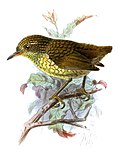Wallace's fairywren
| Wallace's fairywren | |
|---|---|

| |
| Illustration (bird below) | |
| Scientific classification | |
| Domain: | Eukaryota |
| Kingdom: | Animalia |
| Phylum: | Chordata |
| Class: | Aves |
| Order: | Passeriformes |
| Family: | Maluridae |
| Genus: | Sipodotus Mathews,1928 |
| Species: | S. wallacii
|
| Binomial name | |
| Sipodotus wallacii (Gray, G.R.,1862)
| |
| Synonyms | |
| |
Wallace's fairywren(Sipodotus wallacii) is a species ofbirdin theAustralasian wrenfamily, Maluridae. It isthe only specieswithin the genusSipodotus.It is found inNew Guineaand theAru Islands,where its naturalhabitatissubtropicalortropicalmoist lowlandforests.
Taxonomy and systematics
[edit]The Wallace's fairywren is the only member of the monotypic genusSipodotus.
Wallace's fairywren was originally described in the genusTodopsisasTodopsis wallaciibyG. R. Grayin 1862 on the basis of specimens collected by Charles Allen onMisool Island.Specimens from the Aru Islands were described asTodopsis coronatabyJohn Gouldin 1878.Mathewsestablished the monotypic genusSipodotusfor the Wallace's fairywren in 1928 on the basis of the shape of the bill and the nearly identical plumages of the male and female of the species. The species has also been placed in the genus Malurus. When the species is placed in the genusMalurus,the subspecific namecoronatusis preoccupied and is replaced withcapillatus,coined byMayrin 1986.[2]
The species' specific epithet is named afterAlfred Russel Wallace,a Britishnaturalist,explorer, geographer, and biologist.[3]the generic nameSipodotusis an anagram ofTodopsis.[4]Alternate names for Wallace's fairywren include the blue-capped fairywren, Wallace's wren, and Wallace's wren-warbler.
Like other Australasian wrens, Wallace's fairywren is not related to thetrue wrens.The fairywrens were initially thought to be related toMuscicapidae(old-world flycatchers) orSylviidae(warblers), before being placed in the Maluridae in 1975. Recently, DNA analysis has shown the Maluridae to be a part of the superfamilyMeliphagoideawith thePardalotidae(pardalotes) and theMeliphagidae(honeyeaters).[5]
Subspecies
[edit]There are two recognized subspecies:
- S. w. wallacii-Gray, G.R.,1862:The nominate subspecies, it occurs on Misool andYapen Island,theBird's Head Peninsula,and on the north coast of New Guinea, east fromGeelvink Bay.[2]
- S. w. coronatus-Gould,1878:Occurs on the Aru Islands, in southern New Guinea from theSetekwa RivertoMilne Bay,and north to theHydrographer Mountains.When the species is placed inMalurus,the subspecies is known asS. w. capillatus.Females have less buff on the throat and breast than in the nominate subspecies.[2]
Description
[edit]Wallace's fairywren is a small species of fairywren, 11–12.5 cm (4.3–4.9 in) in length and weighing 7–8 g (0.25–0.28 oz). Adult males have a black crown and nape with blue feather tips and a black face with an incomplete whiteeye-ringand white ear-tufts. The scapulars and back are rusty brown, with brownish-grey upperwings, white underparts, and brown tails. The black beak is long, broad, straight, and bluntly pointed, with a white tip. The iris is red-brown, with short, flesh-brown legs. Females are similar to males, but have a pale yellowish wash to the throat and a duller crown. Subspeciescoronatushas a creamy wash to the underparts. Immatures are duller than the adults, with shorter bills and ear-coverts, along with having the crown be speckledbuffinstead of blue.[6]
Little is known about its vocalisations, but hissingsee see see seecalls are given by foraging parties.[6]
Distribution and habitat
[edit]Wallace's fairywren is endemic to New Guinea. It is common throughout New Guinea, except on theHuon Peninsula,eastern Sepik-Ramu, and most of the northern parts of the southeastern peninsula.[7]The species inhabits foothill rainforest and secondary growth between elevations of 100–800 m (330–2,620 ft), although they can be found up to elevations of 1,200 m (3,900 ft) and in lowland plains where there is suitable vegetation.[8]
It is typically found more in trees than in the undergrowth, most commonly from 2–10 m (6.6–32.8 ft) above the ground, but can be found from ground level to 40 m (130 ft) in the canopy. They most commonly inhabit trees with tangles of vines and climbing bamboo at forest edges.[8]
Behaviour and ecology
[edit]Breeding
[edit]Breeding occurs throughout the year, with a peak in September-December. Out of three observed nests, two were attended by three adults each. Nests are domed structures, with a hooded side entrance near the top, and are made out of fine grass,cobwebs,and strips ofpalm frond,lined with finer fibres and sometimes covered with bits ofmossandepiphytes.Nests are placed in vines at a height of 5–10 m (16–33 ft) above the ground, although one nest was built in a 1–5 m (3.3–16.4 ft) tall shrub at the top of a 30 m (98 ft) tall cliff face. Eggs are thought to be laid in clutches of two. Chicks are fed by both parents once they hatch.[6]
Diet
[edit]Wallace's fairywrens are thought to be mainly insectivorous, feeding oninsectsandspiders.They forage by gleaning and probing in forest tangles and thickets. It has been known to forage with mixed species flocks, typically in family groups of 4-8 individuals.[8][7]
Status
[edit]Wallace's fairywren is listed asleast concernby theIUCNdue to its large range and lack of significant population declines. They are common throughout foothill rainforest in their range. However, large-scale clearing of rainforest may be a potential threat.[1]
References
[edit]- ^abBirdLife International (2016)."Sipodotus wallacii".IUCN Red List of Threatened Species.2016:e.T22703712A93933729.doi:10.2305/IUCN.UK.2016-3.RLTS.T22703712A93933729.en.Retrieved15 November2021.
- ^abcRowley & Russell 1997,p. 197.
- ^Beolens, Bo; Watkins, Michael (2003).Whose Bird? Men and Women Commemorated in the Common Names of Birds.London: Christopher Helm. pp. 357–358.
- ^Jobling, James A. (2010).Helm Dictionary of Scientific Bird Names.Christopher Helm.p. 357.ISBN978-1-4081-2501-4.
- ^Barker, F Keith; Barrowclough, George F; Groth, Jeff G (2002-02-07)."A phylogenetic hypothesis for passerine birds: taxonomic and biogeographic implications of an analysis of nuclear DNA sequence data".Proceedings of the Royal Society B: Biological Sciences.269(1488): 295–308.doi:10.1098/rspb.2001.1883.ISSN0962-8452.PMC1690884.PMID11839199.
- ^abcRowley, Ian; Russell, Eleanor (2020-03-04), Billerman, Shawn M.; Keeney, Brooke K.; Rodewald, Paul G.; Schulenberg, Thomas S. (eds.),"Wallace's Fairywren (Sipodotus wallacii)",Birds of the World,Cornell Lab of Ornithology,doi:10.2173/bow.walfai1.01,retrieved2021-09-21
- ^abPratt, Thane; Beehler, Bruce (2014).Birds of New Guinea: The Second Edition.Princeton University Press.p. 402.ISBN978-0-691-09563-9.
- ^abcRowley & Russell 1997,p. 198.
Cited text
[edit]- Rowley, Ian; Russell, Eleanor (1997).Bird Families of the World:Fairy-wrens and Grasswrens.Oxford, United Kingdom:Oxford University Press.ISBN0-19-854690-4.


